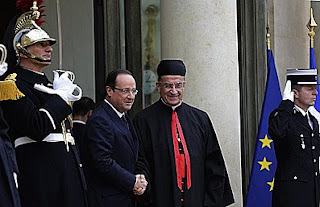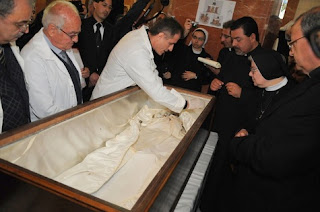66. From Khusūs to the Cathedral: New Attacks on Copts
Sectarian violence struck Egypt again on Friday, April 6, as at least four Christians and one Muslim were killed in an incident in Khusūs, in the governorate of Qalyubia, to the north of Cairo. Clashes continued on Sunday, and spread to the Coptic Orthodox Cathedral in downtown Cairo, where a funeral procession was attacked by unknown assailants. Religious and political leaders have condemned the violence and called for calm, but much about the original incident remains unclear.
The incident was apparently sparked by a group of youth who painted graffiti on the walls of a local Azhar affiliated religious institution. The Azhar is the most prestigious center of religious education in the Sunni Muslim world.
An initial report by CNN quotes Ahmad Usāmah, spokesman for the Egyptian Ministry of Health, who identified these youths as Christians, saying they painted crosses on the wall. Once this became known it angered Muslim residents who attacked the youths, who fled seeking refuge in the local St. George Church. Security then prevented residents from storming the building.
Ahram Online reports that the Egyptian Middle East News Agency also identified the youths as Christians, but did not elaborate on the graffiti. But while Egypt Independent reports that Reuters also identified the youth as Christian, it notes it's Arabic sister publication al-Masry al-Youm reported they were Muslim.
Initial reports also do not explain well how the people died. Ahram Online on Sunday quoted a Reuters report saying someone fired a stray bullet into the air, killing one. Egypt Independent identifies the Muslim killed as Muhammad Mahmūd, age 18. No details are provided on how the Christians were killed, but on Sunday Egypt Independent reports that local forensics determined they were killed by automatic weapons, shot from an angle, downward. Their names are listed as Marsūq 'Attiyah, Murqus Kamāl, Victor Manqarius and 'Isām Zakhārī.
Egypt Independent reported that fifteen people were arrested for rioting, and that security denies the house of the Christian accused of killing Mahmoud was burned. But in a separate article the paper provides the testimony of Fr. Suriyal of the St. George Church, saying that houses and shops in the area were burned, along with his church's nursery and a local Baptist church. Fr. Suriyal attributes the incident to an ongoing family feud which had recently been pacified, a point also reported by local witnesses according to Ahram Online.
According to the priest, however, local Salafis, however, harassed a Christian girl, and their sheikhs incited the population against the Copts. Ahram Online states the priest says six Christians were killed, with many more injured, but in another article has him saying eight people died, four of whom were Christians. A picture by the AP, carried by MSN UK shows four caskets during the funeral at the cathedral. This picture, however, carried over Twitter, seems to show five.
Many of these details are difficult to sort, but investigative reporter Rā'id Sharqāwī visited the area and offers a possible explanation. He collected testimony saying Muslim youths drew the Nazi swastika on the wall, and were confronted by authorities. A crowd gathered, as is common during disputes, and drew in local residents including members of a prominent Christian family living opposite the Azhar institution.
A younger member of this family confronted the Muslim youth, asking him why he was drawing offensive symbols on the wall. In the heated exchange this Christian drew his gun and shot the Muslim, killing him. This produced great tumult in the area, and took place around 12 noon.
The Christians, however, were not killed until around 4pm, and in a manner Sharqāwī found mysterious and perhaps conspiratorial. A group of men armed with automatic weapons drove in from outside the area on motorcycles and fired, somewhat randomly, at a group of assembled Christians. At this time stores were broken into and looted; Sharqāwī surmised it was an organized effort to take advantage of the chaos. The situation was not helped by the diffusion of rumors throughout the village, that each religious community was attacking the other.
If so, it matches the statements issues by the Muslim Brotherhood's Freedom and Justice Party the next day. Party leader Sa'ad al-Katātnī immediately labeled it sectarian violence, saying someone was trying to burn Egypt. In a later official statement the party offered condolences to all victims, stated it was sending a delegation to determine what really happened, and called on the state to reveal the plans of those behind the violence, punish them, and stop this threat.
The Egyptian presidency also offered condolences and called on all citizens to respect the law and avoid harming the nation's security and stability. The Grand Sheikh of the Azhar, Ahmad al-Tayyib, also sent a delegation to discover what happened and work on reconciliation. One of the local family heads involved is named Hassan Abū Rajab.
All the investigations and calls to expose conspiracy did not produce the desired result. On Sunday, following the funeral, unknown assailants attacked the procession. Egypt Independent reported that one died from bird pellets fired from a shotgun, while 29 others were injured. Police fired tear gas to disperse the crowds, but some Copts say they did not prevent attacks on the premises of the church, which was hit by Molotov cocktails. Tear gas also landed inside the cathedral walls, witnesses say.
The article also gives possible other corollary information contributing to the attack, stating the al-Ahram government news agency said mourners smashed local cars on the street, enraging residents. Furthermore, it quotes Coptic activist Rāmī Kāmil, saying some Copts wanted to march to the Ministry of Defense to demand the military take control of the country. Similar information is reported in Ahram Online, which calls the funeral procession politically charged. It also quotes Coptic activist Sally Toma saying a different activist, lawyer Najīb Jibrā'īl, was leading the pro-military march. This video shows him and an unknown Coptic priest chanting for the downfall of the government of the Muslim Brotherhood. Toma states many Copts are divided, all opposing the Brotherhood but many remembering the massacre under the eyes of the military during a Coptic protest at Maspero in October 2011.
Ahram Online reported that clashes renewed in Khusūs at the time of the attack at the cathedral. Pope Tawadros called for calm, wisdom, and restraint, saying he was in constant contact with the authorities. President Mursī issued a statement directly saying the attack on the cathedral was an attack on him personally. The most recent update at the time of writing states two are dead and ninety injured, including eleven policemen.
Further investigations are necessary, as facts remain disputed and motivations hidden. Direct testimony from residents is needed, in particular from the Christian family neighboring the Azhar institute. Also necessary is the report from the local Freedom and Justice Party delegation; what were the results of their investigation?
Is there a conspiracy leveled against the Brotherhood to spark sectarian tension and drive the country to chaos? Or, must they invent a conspiracy to cover over the latent sectarian tension which exists and erupted naturally, in order to blame hidden hands for the failures of their governance? These questions are far beyond the scope of this report or any subsequent investigations. But they are the questions asked accusingly by both sides of the Egyptian street.
The nation is awash in conspiracy, allegation, and rumor, and who can say it does not exist? But it is hoped this report provides a first step at least in gathering the purported facts, to prevent manipulations based on only a sampling of the above.
Criminal investigations are necessary to go any further.
Envoyé de mon iPad jtk







